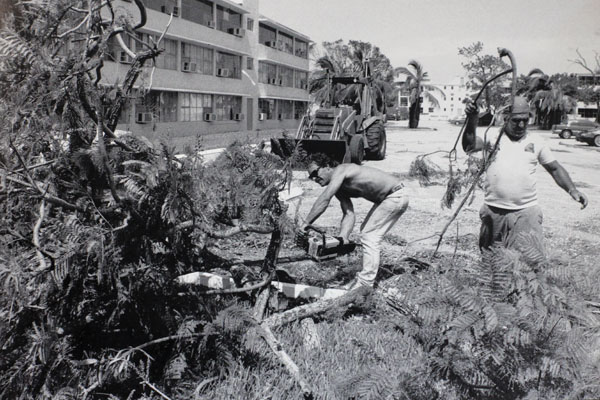
Twenty years ago Thursday night, Patricia Whitely, vice president for student affairs, slept on a mattress on the floor of her office. She lived on campus for three weeks.
Orientation, scheduled for the fourth Sunday in August, was canceled, and classes, scheduled to start Monday, were postponed two weeks.
“I remember walking along the lake at 7 p.m. on Sunday night, and saying that the lake will probably never look the same,” said Whitely, who was the associate director for residence life and staff development at the time.
Hurricane Andrew hit on Aug. 24. Winds reached 145 mph and the university sustained $13.7 million in damages, which included the loss of 52 roofs, 80 windows and 1,300 trees. Some 400 faculty and staff members lost their homes. Miami-Dade had not been in the direct path of a hurricane for 32 years, and the university community expected the storm to turn north.
During the storm, more than 4,000 students and parents stayed on campus. In the Hecht and Stanford residential colleges, those residents and their parents moved to the first through sixth floors and all slept in common areas.
In Mahoney and Pearson Residential Colleges, the students were moved to one side of the hallway, and eventually sent downstairs. There was no electricity and no running water.
“Imagine hundreds of students with non-working toilets,” said Luis Glaser, the special assistant to the president, who was the provost at the time. “That didn’t work very well.”
Annette Gallagher, a UM media relations officer, was a junior living in McDonald tower when the storm hit. She was on campus early, because she had planned to open the Rathskeller the next morning.
“I remember listening to the radio, hearing the guy from the National Hurricane Center tell us that his radar array had just blown off the roof across the street and thinking, ‘Oh my God, we’re all going to die,’” Gallagher said. She is from Pennsylvania and did not know the hurricane would be so strong.
At about 5:30 a.m. on Monday, Gallagher and her roommate’s mother were the only ones awake on the floor.
“I looked at her, and she looked at me and said, ‘I felt it too. Don’t say a word.’ We had both felt the tower sway,” she said.
In case of emergency
The University of Miami created the Office of Emergency Management (OEM) in October 2010, as a way to deal with potential accidents and natural tragedies. The office deals with anything from hurricanes to active shooter cases.
Though the focus is on prevention, the department understands that there will be unexpected issues during disasters and emergencies.
“There are some things we can’t totally eliminate, so we need to be prepared,” OEM Director Scott Burnotes said.
When the office believes there is a serious threat to the university, the crisis decision team will be assembled to discuss a plan of action. The university uses the Emergency Notification Network to quickly disseminate information to students, faculty and staff in the event of a significant threat on campus.Traditionally, communication included text, email and voice notifications. Now, the office also has the capability of taking over cable television, and housing personnel can notify residents over speaker systems.
“Our mission is to protect your mission,” Burnotes said.
Housing arrangements
The Coral Gables campus is not in a storm surge evacuation zone, and therefore would never be evacuated. Since 2002, the university has received $16 million in federal grants to retrofit 35 buildings across all three campuses. This allows the university to shelter students on campus.
“We are in very good shape to take care of the people who live on campus, short of living in World War II bunkers,” Glaser said.
On-campus vendors provide food, generators, and services for emergency repairs and debris clearance during and after a storm. Vendors and other personnel will stay on campus and at the police department when necessary.
The university, however, does not open the campus or a shelter for off-campus students during a hurricane. Locations in Coconut Grove, downtown Miami and Miami Beach – popular residential areas for commuter students – may be located in evacuation zones.
The procedures for housing, according to Jim Smart, director of housing and residential life, are storm-specific. At 45 mph of sustained winds, residential colleges will take a number of actions. At this point, residential colleges will start to bring students into hallways, close doors and encourage students to stay inside.
According to Smart, “the biggest threat for us is not usually the storm itself.” Stagnant puddles of water and live wires can be particularly dangerous.
In Stanford and Hecht residential colleges, students will be moved down to the first through sixth floors, as was the case during Andrew, because the buildings have outdoor stairwells and wind increases with altitude. However, the buildings were designed and built to withstand hurricanes and are sometimes considered the safest structures on campus. Mahoney and Pearson Residential Colleges are concrete-enforced and expected to withstand a storm.
If the hurricane is devastating, students in all on-campus housing arrangements may be sent home after it has passed.
“We’ve been through enough of these things to know that you want to take them seriously,” Smart said.
Future changes
A new design known as the comprehensive emergency management plan, which will be implemented after this year’s hurricane season, will identify specific companies and positions responsible for food, housing, communication and public information. The plan will focus on all hazards, not just hurricanes.
The next version of the UMiami app, which will be released within the next month, will also include an emergency guide.
“For students, my best advice would be to follow advice, follow guidance and don’t try to be tough,” Glaser said. “For everybody else: Be prepared, but don’t panic. It’s easier said than done, but think clearly before you do.”





